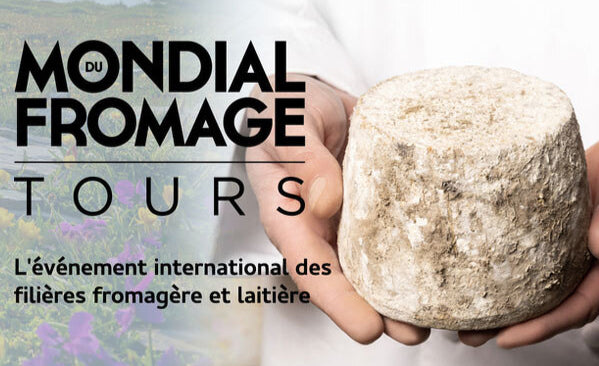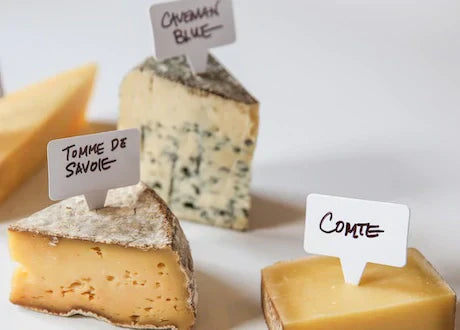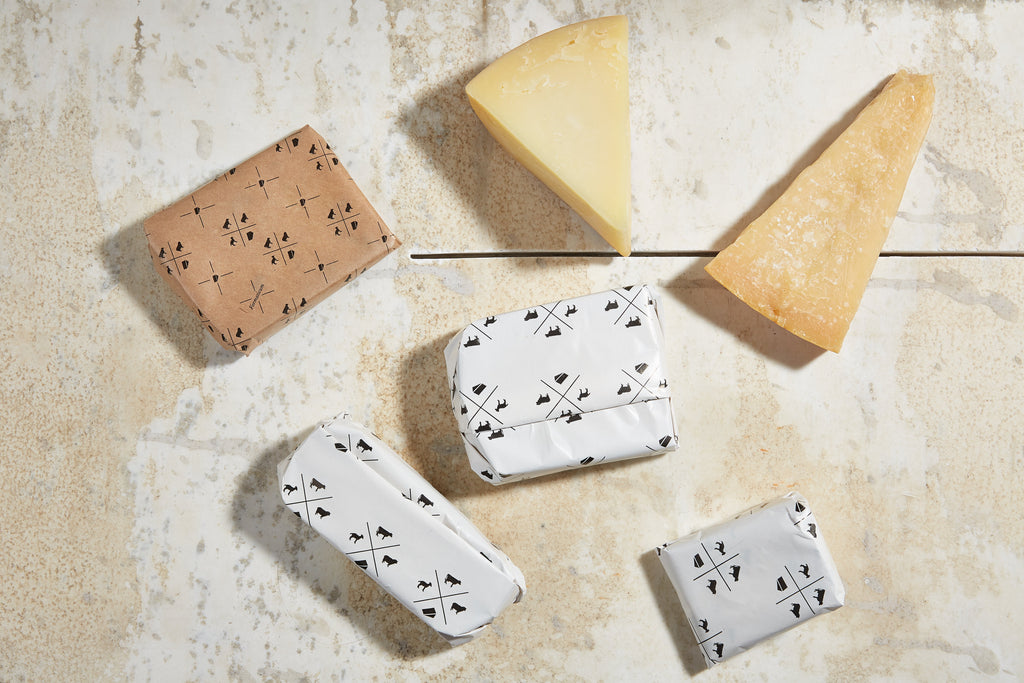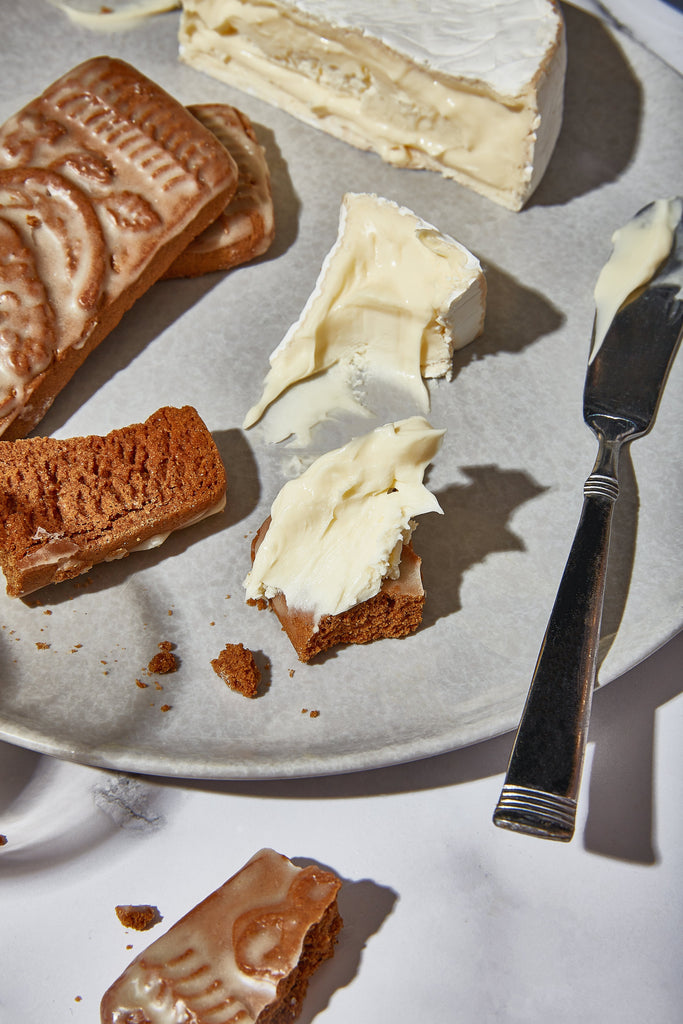Cheesemonger Champions: Team USA's Journey to the Mondial du Fromage 2025


Earlier this year, Formaticum's Sales & Marketing Manager Emilia D'Albero took 1st place in the Cheesemonger Invitational: Masters competition, earning the title of the country's best cheesemonger for 2025. D'Albero, alongside runner-up Courtney Johnson from Seattle, will represent the United States at the Mondial du Fromage in France this September, essentially the World Cheese Olympics. D'Albero (ACS CCP) and Johnson (ACS CCP, CCSE, PhD) make up the very first all-female Team USA, and Johnson is only the second American to qualify to compete in the Mondial du Fromage twice, having competed in 2023 as well.

The Mondial du Fromage is a biannual competition that takes place in Tours, France, and this year's competition features cheesemongers from 15 countries, all working towards the coveted title of World's Best Cheesemonger. For Americans, the opportunity to compete on the world stage is earned through 2 victories: first, a monger must place in the top 3 at the annual Cheesemonger Invitational. Then, they must earn one of the top 2 spots in the biannual Cheesemonger Invitational: Masters competition, where the top 3 mongers from past CMI events are invited to compete against other CMI winners in hopes of hearing their name called to join Team USA.
The Masters competition mirrors the format of the Mondial du Fromage - 9 individual challenges, designed to test cheesemongers across all aspects of their work, including a written test on general cheese knowledge, a 5 minute oral presentation of a cheese of their choice, a blind tasting of 4 PDO cheeses cut in 1cm square (rindless!) pieces, and a perfect .5lb cut challenge involving mystery cheese and absolutely no access to a scale. The day culminates in the notorious Group 3 Challenges - a 4 hour marathon of cheesemongering, where contestants must put together a restaurant quality cheese plate using cheeses revealed only at the start of the test, assemble perfectly paired bites, present a cold dish that transforms an assigned cheese, build an intricate cheese sculpture, and design and assemble a 1 square meter themed cheese display using over 100lb of provided mystery cheeses. The esteemed panel of judges is comprised of top cheese industry professionals from all over the world, providing a variety of viewpoints formed over their combined decades of experience.

In September, Emilia and Formaticum founder Mark Goldman will travel to France alongside Courtney and team coach and CMI founder Adam Moskowitz of Maker to Monger. They will be joined by Maker to Monger's sensory education expert Alex Armstrong and CMI 2021 champion Tommy Amorim of Di Bruno Bros. for support and additional coaching. Having trained for this competition for nearly a year, their goal is simple - for both Emilia and Courtney to be on the podium this year, hopefully with one of them holding the gold medal, as an American monger has never won the Mondial du Fromage…yet.
What does training for the Mondial du Fromage entail? Since November, D'Albero and Johnson have been in constant contact, discussing their ideas, organizing small details like supplies and tools, sharing study resources, and providing each other with emotional support. Both mongers have dedicated a minimum of 2 hours a day to preparing, whether that means recipe testing, studying flashcards, weekly blind tastings, or seemingly endless practice cutting cheese in creative and artistic ways to wow the judges. They have received many generous donations of cheese and other accoutrements from some of the USA's finest cheesemakers and artisans, and they are so thankful to the cheese industry as a whole for the incredible outpouring of support in the past few months. Both competitors have quite literally put their blood, sweat, and tears into this training and are looking forward to giving their absolute best effort and showing the world what American cheesemongers can do!

And if you're wondering what's in a champion's toolkit, don't worry - we'll give you an inside look. D'Albero trusts Formaticum Professional Cheese Knives with Plastic Handles to get those perfect cuts, and even boasts a custom-branded set of Formaticum Parmigiano Reggiano knives. You will never catch her without her 5" Wire Cutter either - simply the best tool for the cleanest, quickest cuts on delicate or soft cheeses. Back in Seattle at her cut-to-order cheese shop Street Cheese, Johnson has her own Professional 4-Knife Set, and also wraps her customers' cheese in Formaticum Reusable Wrap and One-Ply. Of course, the unimaginable amount of cheese in Team USA's fridges are wrapped in Formaticum paper, keeping fresh for cutting and tasting practice.
Follow Team USA's journey to Mondial on Instagram (Emilia's profile and Courtney's profile) and keep an eye on the Formaticum account as well, since we'll be chronicling all our adventures in France, including exclusive cheesemaker tours, cheese shop visits, and more!
Beyond the Paper: Exploring the Formaticum Catalog

Here at Formaticum, we're more than just paper professionals. We're also former cheesemongers, buyers, caterers, importers, and more…so we know that it takes more to run a successful cheese counter than just the right wrapping material. We understand your needs, because we have been in your shoes.
That's why we offer a variety of foodservice items ideal for any catering platter, grazing table, tasting, class, or special event - and we're researching new products and tools to add every day! Check out some of our favorites:
Cheese Signs: available in 3 sizes, these disposable yet sleek signs are perfect for labeling cheeses, cured meats, or anything else you're serving. Let your customers know the milk type, heat treatment, country of origin, or anything else you want them to know about the cheeses they're enjoying.
Bonus: these signs are completely customizable with your logo or design!
Board Liners: Add a touch of elegance to your presentation, while protecting your wooden board, platter, or butcher paper from unsightly grease stains. These greaseproof grape leaf Board Liners are also plastic-free and come in 2 sizes to accommodate any size platter.
Faux Slate Trays: We know the hardest part of choosing catering packaging is finding a tray with a good lid. So, we did the work for you! Our Faux Slate Trays mimic the look of sleek slate, with lids that snap on snugly and allow the trays to be stacked for delivery or display. They are also great for grab & go cheese and charcuterie platters during peak picnic and outdoor party season!
Wood Trays: Made of wood sourced from sustainably-managed forests, these trays provide an attractive, cost-effective and low impact way to sell cheese and its accompaniments. Use them to package grab-and-go pre-cuts, cheese plates, or cheese accompaniments such as dried fruit or nuts on larger platters or boards. Thin, lightweight and biodegradable, they're an appealing and eco-friendly alternative to plastic.
Retail Cheese Storage Bags & Paper: Add value to any tasting or class ticket by including a carton of your favorite cheese storage solution for guests to take home! Email us to inquire about custom-made individually packaged single bag or sheet samples for any event or festival.
Plastic-Handled Knives: Having the right tools can help relieve the stress of any onsite event, class, or even competition. Our best-selling Professional Cheese Knives are now available with black plastic handles for industry use, making them easier to clean without having to oil the handles.
-
Interested in including Formaticum products in your next class or event? Email us to inquire about our Event Partnership Program! We are happy to provide complimentary product for your guests as well as a personalized discount code, with the expectation that you will talk to your audience about the importance of proper cheese storage and how to use the product. Contact us at wholesale@formaticum.com for more details about the Event Partnership Program.
Have a suggestion for a product we should offer? Email us at wholesale@formaticum.com to let us know!
A Cheesemonger's Guide to Formaticum's Bulk Wrapping Materials

You asked, and we listened! Due to numerous customer requests, we are happy to announce to launch of White One-Ply - our best-selling One-Ply cheese paper, now available in plain white and Formaticum-branded white. This new colorway is available as rolls or sheets, in a variety of sizes, and is in stock and ready to ship.
We also wanted to take this opportunity to re-introduce you to our full line of bulk wrapping materials, which is expansive and can feel overwhelming at first glance. This guide is meant to demystify our selection and help you choose the material that best fits your needs, and your cheese. We understand that every cheese is unique and therefore needs a unique storage solution, which is why our offerings span a variety of materials and colors. We hope the below information is helpful, but please don't hesitate to reach out to us directly at wholesale@formaticum.com with any additional questions or concerns.
We strongly recommend requesting sample sheets of any new material before ordering a full case. We encourage you to perform extended testing in your specific environment to ensure satisfactory performance of the material. We are happy to provide ample samples of any of our materials, as customer satisfaction is our main goal.
*Note: Our plastic-free wrapping materials were launched with the intention of providing a plastic-free alternative for those who wanted to reduce the amount of plastic waste they produce, but still be able to preserve their cheese as effectively as possible. While these products do prevent plastic from ending up in a landfill, there is of course a slight tradeoff in performance, as unfortunately plastic is still the most effective material for cheese storage and preservation.
ONE-PLY
Available in brown, white, and Formaticum-branded sheets and rolls.
One-Ply paper is classic cheese packaging 2.0, the same material our best-selling Cheese Storage Bags are made of. Based on the same concept of our flagship Two-Ply, this material is composed of brown paper sprayed with a polyethylene coating. One-Ply is porous enough to allow cheese to breathe while retaining the proper humidity to ensure optimal storage conditions. This durable professional-grade packaging is our most versatile material, and is suitable for all sales environments.
Best for: washed rinds, natural rinds & aged cheeses, but good for all cheese types.
TWO-PLY
Available in plain white, plain brown, or Formaticum-branded white sheets.
Our Two-Ply Cheese Storage paper was the material we first started importing in 2006, and is commonly used in Europe's best cheese shops. Composed of an ultra thin sheet of low density polyethylene laminated to pure fiber paper, allows cheese to breathe and maintains the delicate balance of humidity required to prevent cheese from drying out.
Best for: washed rinds, natural rinds & aged cheeses, but good for all cheese types.
ZERO
Available in plain white sheets or white sheets with green Formaticum branding.
Formaticum Zero is compostable, biodegradable, and recyclable. Made of paper sourced from certified sustainable forests, this plastic-free material has a special cellulose-based coating that makes it greaseproof and porous to oxygen, making it an ideal packaging solution for aged cheese and charcuterie.
Best for: drier, aged cheeses and washed rinds, but good for all cheese types.
REUSABLE SHEETS
Available in plain white sheets or heavy-duty black sheets.
This reusable material uses 40% less plastic than other plastic-based materials. It is composed of 40% calcium carbonate and 60% polyethylene, making it 100% recyclable. It protects against dehydration while regulating gas and water exchange, preserving cheese longer and reducing waste. The sheets can be reused after washing in warm soapy water and air drying.
Best for: all cheese types but especially great for blue cheese and butter.
GREASEPROOF SHEETS
Available in plain white sheets.
Greaseproof sheets are plastic-free, compostable, and biodegradable. This paper performs very important functions: it allows the cheese to breathe and maintains the delicate balance of humidity required to prevent cheese from drying out. This paper is manufactured in France specifically for cheese and is used by many of the finest French cheese, butter, and charcuterie purveyors.
Best for: blue cheese, butter, and charcuterie, but good for washed rinds as well.
SUPER WAX
Available in plain white sheets.
Super Wax sheets are made with a vegetable-based wax coating on both sides of the sheet, and both sides of the paper are suitable for food contact. This paper is manufactured in France specifically for cheese and is used by many of the finest French cheese purveyors.
Best for: blue cheese and butter, but good for washed rinds and sheep’s milk cheeses as well.
BROWN ALIOS
Available in plain brown sheets.
Brown Alios is plastic-free, making it compostable, biodegradable, and recyclable. This French brown Kraft paper has Alios stripes to give a classic French presentation. The light vegetable wax coating makes this plastic-free material greaseproof yet porous to oxygen, making it an ideal packaging solution.
Best for: blue cheese, washed rinds, aged cheese, butter, and charcuterie.
CELLOPHANE
Available in clear sheets.
This transparent material is made specifically for wrapping cheese by our manufacturer in France. Our Cellophane is derived from wood-based cellulose fibers designed to be permeable to moisture and allow oxygen exchange. Its porous properties are especially ideal for bloomy and geotrichum-rinded cheeses. This Cellophane is not treated with any plasticizers, is 100% biodegradable, and can be composted in a commercial facility.
Best for: bloomy rinds & geotrichum rinds, but good for blue cheese and washed rinds as well.
PERFORATED CELLOPHANE
Available in clear sheets.
This transparent material is made specifically for wrapping cheese by our manufacturer in France. It is derived from wood-based cellulose fibers designed to be permeable to moisture and allow oxygen exchange. Micro perforations make these sheets great for geotrichum candidum-rinded cheeses that like extra airflow to keep rinds healthy and happy. These sheets are not a good fit for penicillium candidum that can grow through the perforations. Cellophane is not treated with any plasticizers, and is 100% biodegradable. Please note that these sheets have visible micro perforations.
Best for: geotrichum-rinded cheeses.
For more information on our materials, the ordering process, and custom printing, please visit our FAQ page or contact us at wholesale@formaticum.com.
Love at First Bite: Cheesy Romance for Valentine's Day

Chef Anthony Bourdain once famously said, "You have to be a romantic to invest yourself, your money, and your time in cheese." Sharing a good piece of cheese with a partner, family member, good friend, or even a stranger is one of the highest acts of love, in our opinion, and Valentine's Day is the perfect opportunity to do so. Many customers will inevitably ask for "your most romantic cheese" in anticipation of the holiday, and we wanted to provide a few suggestions and talking points for what we here at Formaticum consider to be romantic cheeses!
The mythical origin story of Gorgonzola and many other blue cheeses is one of the most well-known pieces of cheese-related lore, but never fails to entertain a customer. According to legend, a cheesemaker who had just finished the evening milking was distracted by his lover, and came back the next morning to the milk still in the vat. In an attempt to hide his indiscretion, he added the morning milking to the vat and covered the evening milk, which of course contained some very active bacteria after its night in the vat. The result was a cheese containing blue mold, which was discovered to be very delicious, and the rest is history. In this case, an act of love actually helped invent a brand new cheese!
Soft, creamy cheeses hold a romantic place in history as well. In 774, the Emperor Charlemagne was visiting a monastery where the monks were busy making an unfamiliar soft cheese with a bloomy white rind, which would come to be known as Brie de Meaux. Charlemagne fell in love with this cheese with his first bite, and demanded that it be sent to him annually from then on. He wasn't the only royalty to fall in love with Brie - King Louis XVI's dying wish was to have one last bite of Brie!
Soft cheeses like Brie and triple creams are the perfect pairing with bubbly beverages like Champagne, Prosecco, or non-alcoholic sparkling cider. They also contain high levels of phenylethylamine, known colloquially as the "love drug," which causes the body to produce dopamine and feelings of contentment.
Cheddar itself is a universally loved cheese, but did you know that America's first cheese factory was opened in 1951 by a husband and wife team? Jesse Williams is generally credited with opening the factory, but his wife Amanda was also a well-known cheesemaker at the time, and the factory was known for producing cheddar.
There is also something very romantic about the continued preservation of centuries of cheese history. The image of farmers leading their herds of flower- and bell-adorned cows down from mountain pastures is almost synonymous with mountain or Alpine cheeses like Beaufort, Gruyère, and even Ossau Iraty, presenting a romanticized perception of the time-honored tradition of transhumance.
And sometimes, we love a cheese so much that we simply don't want to share it with anyone, For many people, this cheese is aged Gouda - these cheeses contain tyrosine crystals, which encourage the body to produce dopamine and epinephrine, creating feelings of euphoria. They're part of the reason why we love cheese so much!
Providing proper care is an important act of love towards cheese. So, whichever cheese your customers choose to share with their loved ones, remember to wrap it in Formaticum cheese paper to keep it in the best possible condition. Browse our bulk wrapping material selection or email wholesale@formaticum.com to request a wholesale account.

Formaticum News
Our home to share our cheese chronicles and more.
Categories
Recent Posts
Cheesemonger Champions: Team USA's Journey to the Mondial du Fromage 2025
Beyond the Paper: Exploring the Formaticum Catalog
A Cheesemonger's Guide to Formaticum's Bulk Wrapping Materials
Upcoming Events
Connect with Us
Join the Newsletter
Sign up to receive special offers, new product releases, updates from the cheese shop, and more.
